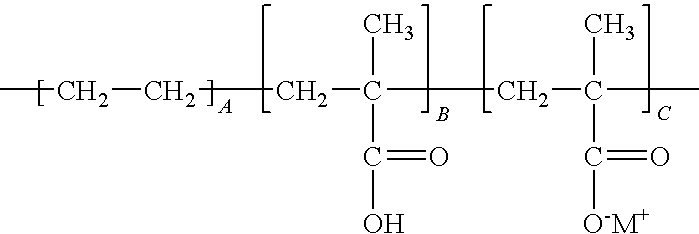Fluoropolymer laminate
a fluoropolymer and laminate technology, applied in the field of laminates, can solve the problems of poor cell function, poor heat dissipation effect, and inability to fully maintain the inner layer over the life of the laminate, and achieve the effect of reducing the number of sinterings
- Summary
- Abstract
- Description
- Claims
- Application Information
AI Technical Summary
Benefits of technology
Problems solved by technology
Method used
Image
Examples
example 1
[0120]An unmodified ETFE resin from Daikin was extruded into a 2 mils film and surface treated by corona in presence of acetone vapors. The film is surface treated by corona in the presence of acetone vapor with nitrogen blanketing. The film is passed beneath the corona electrodes at a distance of about 1 mm at a speed of 100 feet per minute, using a power source of 7.8 kW to deliver a treatment strength or watt density of 12-16 kW / ft2 / min. An ionomer resin supplied by DuPont grade PV4000 was dried and pressed out into a 7 mils film using a heated press set at 350 F under 15 tons for 5 minutes. Then, the ETFE and ionomer films were heat laminated at 350 F with a ChemInstruments HL-100 hot roll laminator with a nip pressure dial setting of 40 psi and a speed of 2.6 fpm. The upper roll was anodized teflon coated aluminum. The lower roll was aluminum covered with 80 durometer silicone rubber. Finally, the laminate was irradiated by UV wavelength delivered by a H-Bulb using 600 W / inch. ...
example 2
[0122]An unmodified ETFE resin from Daikin was extruded into a 2 mils film and surface treated by corona in presence of acetone vapors. The film is surface treated by corona in the presence of acetone vapor with nitrogen blanketing. The film is passed beneath the corona electrodes at a distance of about 1 mm at a speed of 100 feet per minute, using a power source of 7.8 kW to deliver a treatment strength or watt density of 12-16 kW / ft2 / min. A polyolefin resin supplied by Mitsui grade Notio PN3560 (a polyolefin elastomer) was pressed out into a 7 mils film using a heated press set at 350 F under 15 tons for 5 minutes. Then, the ETFE and polyolefin films were heat laminated at 350 F with a ChemInstruments HL-100 hot roll laminator with a nip pressure dial setting of 40 psi and a speed of 2.6 fpm. The upper roll was anodized teflon coated aluminum. The lower roll was aluminum covered with 80 durometer silicone rubber Finally, the laminate was irradiated by UV wavelength with using 600 ...
PUM
| Property | Measurement | Unit |
|---|---|---|
| adhesive strength | aaaaa | aaaaa |
| frequency | aaaaa | aaaaa |
| thickness | aaaaa | aaaaa |
Abstract
Description
Claims
Application Information
 Login to View More
Login to View More - R&D
- Intellectual Property
- Life Sciences
- Materials
- Tech Scout
- Unparalleled Data Quality
- Higher Quality Content
- 60% Fewer Hallucinations
Browse by: Latest US Patents, China's latest patents, Technical Efficacy Thesaurus, Application Domain, Technology Topic, Popular Technical Reports.
© 2025 PatSnap. All rights reserved.Legal|Privacy policy|Modern Slavery Act Transparency Statement|Sitemap|About US| Contact US: help@patsnap.com

